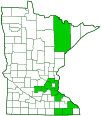narrow-leaved mountain mint
(Pycnanthemum tenuifolium)
Conservation • Wetland • Description • Habitat • Ecology • Use • Distribution • Taxonomy
Conservation Status |
|
|||||||
| IUCN Red List | not listed |
|||||||
| NatureServe | N5 - Secure SNR - Unranked |
|||||||
| Minnesota | not listed |
|||||||
Wetland Indicator Status |
||||||||
| Great Plains | FAC - Facultative |
|||||||
| Midwest | FAC - Facultative |
|||||||
| Northcentral & Northeast | FAC - Facultative |
|||||||
Description |
||
Narrow-leaved mountain mint is a 20″ to 32″ tall, erect, perennial forb that rises from spreading rhizomes. It often forms colonies. The stems are erect, square, green or reddish, hairless, and frequently branched above the middle. The leaves are numerous, opposite, stalkless, and linear. The main leaves are ¾″ to 2″ long, and usually 1 ⁄16″ to ⅛″ wide, the upper leaves much smaller. The largest leaves are never more than ¼″ wide. The upper surface is hairless. The lower surface often has short, soft hairs along the midvein. The margins are untoothed and rough to the touch. There is a prominent midvein and usually 1 or 2, sometimes 3, pairs of lateral veins. All lateral vein arises in the lower quarter of the leaf. Crushed leaves have almost no scent. The inflorescence is a branched arrangement of multiple compact, flat-topped, head-like clusters at the end of the stem and branches. The inflorescence is about 3″ wide. Each cluster is about ¾″ wide and is composed of up to 50 flowers. Only a few flowers in each head are open at the same time. The flowers are about ¼″ long and usually white or pinkish. There are 5 petals fused at the base into a corolla tube then separated into an upper and lower lip. The upper lip is erect and unlobed, and may be notched. The lower lip is bent backward, divided into a central lobe and 2 shorter lateral lobes, and sometimes spotted with pink or violet. There are 4 stamens protruding sligjtly from the corolla tube. Each stamen has an anther that is yellow to pink when fresh, soon turning brownish-red when dry. There is a style with 2 stigmas protruding well beyond the corolla tube. The fruit is a dark brown, egg-shaped or oval nutlet about 1 ⁄32″ long. |
||
Height |
||
20″ to 32″ |
||
Flower Color |
||
Pink to white |
||
Similar Species |
||
Virginia mountain mint (Pycnanthemum virginianum) stems have short, white hairs mainly along the ridges. The leaves are linear, wider, ⅛″ to ⅜″ wide. There are 3 or 4 pairs of lateral veins. The uppermost lateral veins arise near the middle of the leaf. Crushed leaves have a strong mint scent. |
||
Habitat |
||
Dry. Upland woods, prairies. |
||
Ecology |
||
Flowering |
||
July to September |
||
Pests and Diseases |
||
|
||
Use |
||
|
||
Distribution |
||||
|
Sources |
|||
| 5/17/2023 | ||||
Nativity |
||||
Native to 31 states, including Iowa, and to Ontario and Quebec. Introduced to Minnesota and Wisconsin. Locally established. |
||||
Occurrence |
||||
Uncommon in Minnesota |
||||
Taxonomy |
|||
| Kingdom | Plantae (Plants) | ||
| Division | Tracheophyta (Vascular Plants) | ||
| Subdivision | Spermatophytina (Seed Plants) | ||
| Class | Magnoliopsida (Dicots) | ||
Order |
Lamiales (Mints, Plantains, Olives, and Allies) | ||
Family |
Lamiaceae (Mint) | ||
| Subfamily | Nepetoideae | ||
| Tribe | Mentheae | ||
Subtribe |
Menthinae (balms, mints, and thymes) | ||
| Genus | Pycnanthemum (mountain mint) | ||
Subordinate Taxa |
|||
|
|||
Synonyms |
|||
Koellia flexuosa Koellia hugeri Koellia hyssopifolia Pycnanthemum flexuosum Pycnanthemum hyssopifolium |
|||
Common Names |
|||
narrow-leaf mountain-mint narrow-leaved mountain mint narrowleaf mountainmint slender mountain mint |
|||
Glossary
Linear
Long, straight, and narrow, with more or less parallel sides, like a blade of grass.
Rhizome
A horizontal, usually underground stem. It serves as a reproductive structure, producing roots below and shoots above at the nodes.
Visitor Photos |
|||||
Share your photo of this plant. |
|||||
| This button not working for you? Simply email us at info@MinnesotaSeasons.com. Attach one or more photos and, if you like, a caption. |
|||||
|
|||||
MinnesotaSeasons.com Photos |
|||||
|
|||||

Visitor Videos |
|||
Share your video of this plant. |
|||
| This button not working for you? Simply email us at info@MinnesotaSeasons.com. Attach a video, a YouTube link, or a cloud storage link. |
|||
Other Videos |
|||

Visitor Sightings |
|||||
Report a sighting of this plant. |
|||||
| This button not working for you? Simply email us at info@MinnesotaSeasons.com. Be sure to include a location. |
|||||
|
|||||
MinnesotaSeasons.com Sightings |
|||||
|
|||||

|
Created: Last Updated: © MinnesotaSeasons.com. All rights reserved. |


